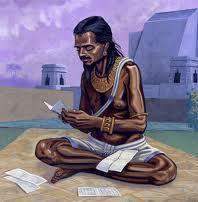La
biografía que viene a continuación fue tomada de EcuRed y nos adentra en la
vida de Brahmagupta:
Fue
un matemático y astrónomo indio. Fue el jefe del observatorio astronómico en
Ujjain, y durante su mandato allí escribió cuatro textos sobre las matemáticas
y la astronomía: Cadamekela en el 624, Brahmasphutasiddhanta en 628,
Khandakhadyaka en 665, y Durkeamynarda en 672.
Su
padre fue Jisnugupta. Nació en el año 598, posiblemente en Ujjain, donde vivió.
En esta ciudad de la zona central de la India se encontraba el más famoso y
antiguo observatorio de astronomía del que Brahmagupta era el director. Está
considerado el más grande de los matemáticos de esta época. Murió en el año
670.
Es
posible que Brahmagupta haya sido el idealizador del concepto del
"cero" ya que en su obra Brahmasphutasiddhanta del año 628 aparece
por primera vez esta idea. La obra trataba también sobre aritmética y números
negativos en términos muy parecidos a los de la moderna matemática.
Su
actividad tuvo lugar en Ujjain, en el noroeste de la India, zona que, durante
siglos antes y después de él, constituyó el núcleo central de la ciencia
indostana. Brahmagupta resumió sus conocimientos astronómicos en un libro
escrito en el año 628, y en este rechazaba la rotación de la Tierra, idea esta
que algunos astrónomos indostanos defendían.
El
rasgo más notable del libro es la aplicación de métodos algebraicos a los
problemas astronómicos. Ciertamente, los matemáticos indostanos rindieron un
gran servicio al mundo, ya que, en una fecha indeterminada situada dentro de
los dos siglos siguientes, un matemático anónimo ideó el concepto y el símbolo
«cero». Esto prestaba a la notación posicional importancia práctica y,
consiguientemente, se adoptó un sistema numérico basado en dicha notación. Este
sistema se extendió a los árabes, como en el caso de Al-Khwarizmi, y a partir
de ellos fue introducido en Europa (los «números arábigos» en uso hoy en día)
por hombres como Fibonacci.
Referencia bibliográfica:
Brahmagupta, (s. f). En EcuRed.
Recuperado el 20 de septiembre de 2016 de https://www.ecured.cu/Brahmagupta
____________________
Brahmagupta
Early Life
and Work
Brahmagupta was an Indian mathematician, born
in 598 AD in Bhinmal, a state of Rajhastan, India. He spent most of his life in
Bhinmal which was under the rule of King Vyaghramukha. He was the head of the
astronomical observatory at Ujjain which was the center of mathematics in India
witnessing the work of many extraordinary mathematicians.
Brahmagupta wrote many textbooks for
mathematics and astronomy while he was in Ujjain. These include ‘Durkeamynarda’
(672), ‘Khandakhadyaka’ (665), ‘Brahmasphutasiddhanta’ (628) and ‘Cadamakela’
(624). The ‘Brahmasphutasiddhanta’ meaning the ‘Corrected Treatise of Brahma’
is one of his well-known works. It contains a lot of criticism on the work of
his rival mathematicians. Brahmagupta had many discrepancies with his fellow
mathematicians and most of the chapters of this book talked about the loopholes
in their theories.
Contributions
to Mathematics
One of the most significant input of
Brahmagupta to mathematics was the introduction of ‘zero’ to the number system
which stood for ‘nothing’. His work the ‘Brahmasphutasiddhanta’ contained many
mathematical findings written in verse form. It had many rules of arithmetic
which is part of the mathematical solutions now. These are ‘A positive number
multiplied by a positive number is positive.’, ‘A positive number multiplied by
a negative number is negative’, ‘A negative number multiplied by a positive
number is negative’ and ‘A negative number multiplied by a negative number is
positive’. The book also consisted of many geometrical theories like the
‘Pythagorean Theorem’ for a right angle triangle. Brahmagupta was the one to
give the area of a triangle and the important rules of trigonometry such as
values of the sin function. He introduced the formula for cyclic
quadrilaterals. He also gave the value of ‘Pi’ as square root ten to be
accurate and 3 as the practical value. Additionally he introduced the concept
of negative numbers.
Contribution
to Science and Astronomy
Brahmagupta argued that the Earth and the
universe are round and not flat. He was the first to use mathematics to predict
the positions of the planets, the timings of the lunar and solar eclipses.
Though all this seems like obvious and simple solutions it was a major
improvement in science at that time. He also calculated the length of the solar
year which was 365 days, 5 minutes and 19 seconds which is quite accurate based
on today’s calculation of 365 days, 5 hours and 19 seconds. He also talked
about ‘gravity’ in one of his statements saying: ‘Bodies fall towards the earth
as it is in the nature of the earth to attract bodies, just as it is in the
nature of water to flow’.
Death
This great mathematician died between 660 and
670. He was one of the greatest mathematicians in Indian history and his
contributions to mathematics and science have made major differences to various
mathematical problems by establishing the basic rules which now allow us to
find their solutions. He was honored by the title given to him by a fellow
scientist ‘Ganita Chakra Chudamani’ which is translated as ‘The gem of the
circle of mathematicians’.
Referencia bibliográfica:
Brahmagupta,
(s. f). En Famous Mathematicians. Recuperado el 20 de septiembre
de 2016 de http://www.famous-mathematicians.com/brahmagupta/


No hay comentarios:
Publicar un comentario